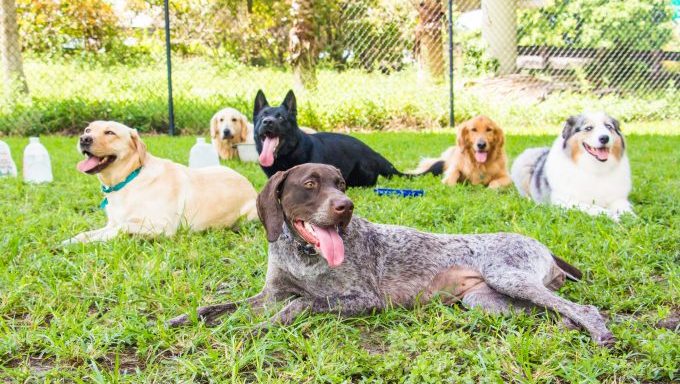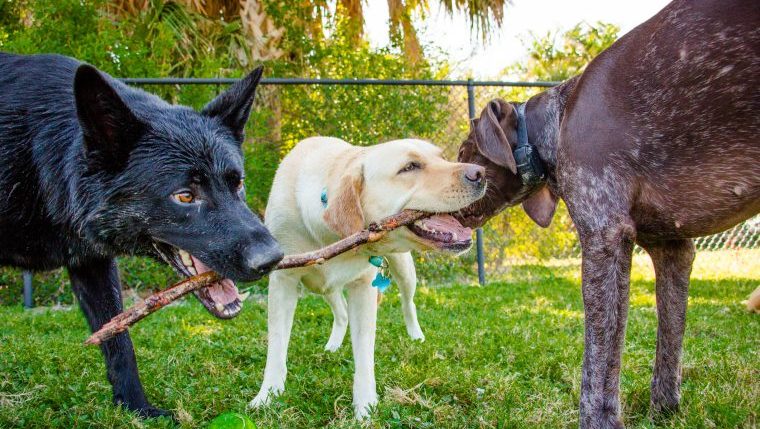
Dog parks can be a wonderful place for a dog to burn off some energy. Besides providing a safe place for a dog to run and play, they facilitate important opportunities for enrichment and play. Particularly for young dogs, dog parks can be an excellent place for canines to socialize. However, sometimes the fun can be ruined by a dog (or owner) who isn’t on their best behavior. Dog park safety is important for both pets and people. Nobody wants to get bitten on a day out at the park. Some dog park etiquette may seem self-explanatory. But, it can also be overwhelming for new dog owners or owners of dogs with physical or behavioral challenges. So how can you ensure dog park safety with your own pet?
1. Follow the rules of the dog park
This may seem straightforward, but it’s also commonly forgotten by dog owners. Most dog parks have a posted set of rules; often, on a signpost or fence. If you don’t see one, give your local dog park a Google just to be sure you aren’t missing something. Dog park rules often outline what dogs are allowed to come and play. Usually, it’s required that your dog is up to date on their vaccinations. Some parks aren’t free-roam and may require leashes while you explore. And, due to concerns of behavioral issues or “happy accidents,” many parks don’t allow unaltered (spayed or neutered) dogs. Review your local park’s rules before you visit to be sure you’re abiding by them.
2. Prepare your dog for the dog park
Before you set off for an afternoon of fun, be sure your dog is ready. Dogs aren’t inherently well-versed in dog park safety, so it’s up to you as an owner to determine whether or not a dog park is appropriate for them. Review basic commands with your dog before attending. If you plan on letting your dog off leash to play, it’s especially important to be sure they have a good recall.
Some shy dogs may enjoy a dog park, but take some time to warm up. If you have any doubts about your dog, it’s best to play it safe and take it slow. Let your dog meet others slowly, and if they have a wagging tail and no signs of fear or aggression, let them play. If you’re not sure that your dog is ready to jump in to a sometimes hectic dog park environment, see how well they do on a smaller scale, such as visiting a pet store.
3. Watch your dog carefully
Dog park safety relies on dutiful owners who are capable of recognizing problem behaviors. It’s important that you stay engaged with what your dog is up to, even if they aren’t directly playing with you. A dog park isn’t the place to answer a call or check your email. Keep a set of eyes on your pup. Some barking and growling is normal in playing dogs, and not a sign of concern. But if the growling is excessive, or a dog is “hard barking” (barking with a stiff posture and/or charging), remove your dog from the situation. Raised hackles, curled lips, and stiff tails are other signs that a dog is feeling aggressive or threatened, not playful.
If you sense that a situation is taking a turn for the worse, remove your dog. This may look like redirecting your dog to a new play partner, or it may mean that you leave the park entirely. If the park is off-leash, keep a leash on you in case you have to abruptly remove your pet. While it’s fair to expect others to remove their aggressive dogs from the park, this isn’t always the case. You may encounter owners who insist their dog’s behavior is fine, even if you feel unsafe. Don’t risk it; it’s better to skip the park and come back another day when there are friendlier playmates for your pet.
4. Follow good dog park etiquette
If you want others to enjoy your presence at the park, be a good guest and encourage your pet to be one, too. Bring along poop bags to clean up any messes. Most dog parks have trash cans where you can dispose of poop bags, but be prepared to carry them in case they don’t. You likely shouldn’t bring toys, unless you’ve checked in with the owners of other dogs who are present. Even the friendliest dogs can become possessive of a cool new toy, and you could accidentally start a fight with your dog’s favorite rope tug.
Familiarize yourself with frequent park visitors for the best communication. This doesn’t mean you have to become close friends with every other dog owner. However, it helps to know routine dogs’ names and behavior patterns so you can anticipate how your pup’s park visit will play out. If someone’s dog is prone to getting overexcited or bothering your pup, it may be worth asking if the owner feels comfortable with you offering redirection to their dog.
There are also some pretty blatant things that shouldn’t ever occur, such as bringing a dog who isn’t feeling well to the park. Review our guide to things you should never do at the dog park.
5. Bring the right supplies
Be sure that you have everything you need for your outing before you arrive. Many dog owners keep a bag full of essentials in the car so you’re never left without something you need. On a basic level, you should bring water for yourself and your dog, and poop bags for any waste. You may want to consider more advanced supplies such as a backup leash or pet first aid kit in case of emergency, too.
6. Keep your dog hydrated
It’s important to keep your dog hydrated during their park visits. Dogs aren’t particularly good at monitoring their own water intake, and they may prefer to run around and play with their friends until they’re at the point of exhaustion rather than take a water break. Take regular breaks from play to call your pet aside for a drink. And, on hot days, you may want to limit your playtime to a short visit.
7. Protect your dog from the sun
It may come as a surprise, but overexposure to sunshine can be harmful to your pet, too. Dogs with very short coats, such as many bully breeds, are especially prone to sunburn. Sunscreen for dogs exists, and it can be helpful in preventing burns, especially on sensitive skin such as around the nose and mouth.
It’s also possible for dogs to suffer from heat stroke, particularly if they’re engaging in strenuous exercise on a hot day. Heavy panting, excessive drooling, and excessive thirst are all signs of heatstroke onset; if you notice your dog isn’t feeling well, take them home and get them a drink ASAP.
8. Time your dog park visit
Some of the success of a great dog park visit can be attributed to other guests and the weather at the park. Find a time that works best for you and your canine’s comfort level. If your dog is friendly with other dogs, but gets overwhelmed, you might want to avoid the park on weekends, when traffic is usually high. You might have the most fun taking your dog in the early morning or evening, when less people and dogs are present. And check the weather forecast before you head out! You likely won’t enjoy standing in the rain and then washing off a muddy dog at home, but it’s also not safe to bring your pet if it’s too hot out.
9. Leave aggressive dogs at home
Dogs with aggressive or reactive behaviors can still be a beloved part of the family. These behaviors don’t make a dog less special or loved. However, their experiences will have to be somewhat different than most dogs for everyone’s safety. Dog park safety is impossible if you’re setting your dog up to fail. If you suspect your dog has the potential to attack another dog, leave them at home so there’s no chance of a negative incident. Your dog – and other guests – will be happier and safer if only friendly dogs attend the park.
10. Know when to leave
There is such a thing as too much of a good thing. Learn to recognize when your pup has had enough fun for the day. Some overtired dogs may act similarly to overtired children – throwing fits, behaving badly, or acting erratically – which can turn a dog park trip sour. They may also just feel too exhausted to keep playing with so many friends! Assess your dog’s behavior frequently. Do they seem less enthusiastic about playing after a while at the park? Are they avoiding other dogs, or perhaps seeking out other dogs to the point that they’re “annoying”? When your dog is showing signs that they’ve had enough, call your dog park trip on a good note and head home for the day.









